When Did Homeschooling Become Legal Again in Us
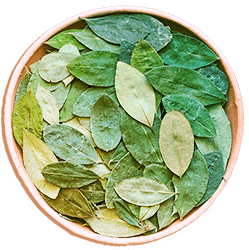 Cocaine and information technology's exquisitely addictive influence stand as such powerful points of reference in American culture that when a 2013 report suggested that Oreo cookies were as addictive as cocaine , the findings fabricated "thousands of headlines," co-ordinate to the Huffington Mail. one, 2 Such claims are only another addition to the long, turbulent, and scandalous history of cocaine in America—an inevitable union of the earth's most powerful country and one of the world's deadliest drugs.
Cocaine and information technology's exquisitely addictive influence stand as such powerful points of reference in American culture that when a 2013 report suggested that Oreo cookies were as addictive as cocaine , the findings fabricated "thousands of headlines," co-ordinate to the Huffington Mail. one, 2 Such claims are only another addition to the long, turbulent, and scandalous history of cocaine in America—an inevitable union of the earth's most powerful country and one of the world's deadliest drugs.
The Roots of Cocaine

To improve understand cocaine'south place in America, and how it got hither, it's important to run into where it comes from, and how the development of diverse sciences and policies shaped its authorization, reputation, and illegal status.
The coca plant grows in the jungles of Peru, Bolivia, Colombia, and neighboring countries. Historically, people in these regions would chew the leaves of the plants in the coca family, partly for its nutritional value, but also considering consuming the leaves would impart stimulant and analgesic furnishings. Such a custom provides the first glimpse into how cocaine became a household proper noun across the world.
The chief psychoactive chemical compound in the coca establish is cocaine; however, the cocaine content in the raw leaves is very low, beneath one percent. Chewing the leaves, grinding them into powder, and mixing them into tea, is unlikely to produce the infamous euphoria, or lead to potentially devastating concrete and mental damage, equally is the case when cocaine is injected or snorted.
The Medical Revolution
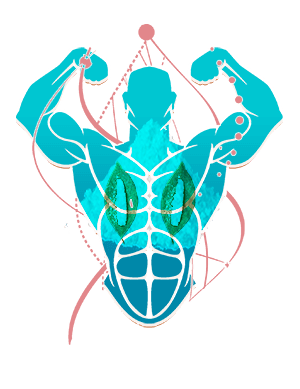 In Drugged: The Science and Civilisation Behind Psychotropic Drugs, author Richard J. Miller posits that European (primarily Spanish) explorers and colonists observed how the natives they conquered were rarely without the coca leafage in their mouths and, as a result, adopted the addiction themselves.iii Discussion nigh how the coca leaves helped indigenous peoples stave off exhaustion and hunger made its fashion across the sea to Europe, where the scientists of the early on 19th century eventually extracted pure cocaine equally a white, crystalline substance. A historian writes that this more concentrated cocaine extract was "tens to hundreds of times more than powerful" than simply munching down on the coca leaf.
In Drugged: The Science and Civilisation Behind Psychotropic Drugs, author Richard J. Miller posits that European (primarily Spanish) explorers and colonists observed how the natives they conquered were rarely without the coca leafage in their mouths and, as a result, adopted the addiction themselves.iii Discussion nigh how the coca leaves helped indigenous peoples stave off exhaustion and hunger made its fashion across the sea to Europe, where the scientists of the early on 19th century eventually extracted pure cocaine equally a white, crystalline substance. A historian writes that this more concentrated cocaine extract was "tens to hundreds of times more than powerful" than simply munching down on the coca leaf.
The numbing properties of cocaine caught the attention of an Austrian ophthalmologist, whose utilise of the substance as an anesthetic for eye surgery was met with success and praise across Europe. Prior to his intervention, eye surgery was considered all but impossible because of the minute and reflexive motions of the eyeball to the slightest stimuli. Cocaine every bit an coldhearted allowed a doctor fuller range of performance, piquing the involvement of doctors of various fields (such as dentistry).
Every bit cocaine's medicinal fame spread, its recreational furnishings did not go unnoticed. A French chemist combined wine and cocaine to produce Vin Mariani. There were vi milligrams of cocaine in each ounce and a full bottle of Vin Mariani contained around 200 milligrams of cocaine. Believing that the drinkable could improve health and vitality, too as boost energy, the concoction was endorsed by high contour figures such as Thomas Edison, Ulysses South. Grant, and two popes.
Cocaine Reaches America
Two Americans took annotation of the European cocaine craze. One was a surgical pioneer past the name of William Stewart Halsted. Halsted, too, was taken with the thought of using cocaine every bit a painkiller and set most experimenting with the drug—on himself, his colleagues, and his friends. Even as Halsted himself brutal under the spell of cocaine, and in the procedure becoming a mental and physical wreck, unable to command his addiction, cocaine enjoyed such a wave of popularity in the United States that the negative effects of the drug were largely ignored or cached.4
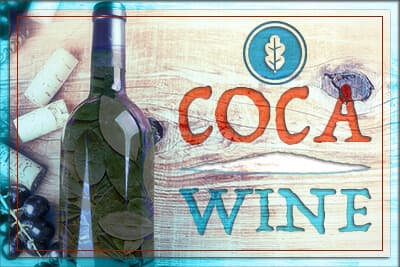
One man who cashed in on cocaine's public appeal was John Pemberton, who was inspired past the commercial success of Vin Mariani and decided to try his own hand at creating a cocaine-based drink in the United states of america. Wounded in the Civil State of war and fond to morphine, Pemberton attempted using cocaine equally a course of handling. One attempt utilized his knowledge of pharmacy to develop what he called"Pemberton's French Wine Coca," which he marketed as a cure-all for any number of ailments and even as an aphrodisiac (or, every bit he put it, "a most wonderful invigorator for the sexual organs").5
However, Pemberton's dwelling house land of Georgia enacted temperance legislation in 1885, outlawing the sale of booze. With his French Wine Coca now barred from really having any vino in it, Pemberton replaced the vino with carbohydrate and marketed the new product that would eventually exist trademarked and known as Coca-Cola.half-dozen
The 'Cocaine Fiend'
 The effect that cocaine had on William Halsted, whomTheNew York Times calls both the founder of modern American surgery and a lifelong drug aficionado, heralded the end of the cocaine honeymoon.seven As cases of devastating addiction and mental health damage started to be continued to cocaine utilize, the drug savage out of favor with a once-enraptured American public. Sigmund Freud, who publicly advocated cocaine'southward effectiveness in treating anxiety and low, was similarly "nearly destroyed" by his use of the drug, and in the words of PBS'sNewshour, recanted his support of cocaine after he experienced frequent nosebleeds and irregular heartbeats.8, nine
The effect that cocaine had on William Halsted, whomTheNew York Times calls both the founder of modern American surgery and a lifelong drug aficionado, heralded the end of the cocaine honeymoon.seven As cases of devastating addiction and mental health damage started to be continued to cocaine utilize, the drug savage out of favor with a once-enraptured American public. Sigmund Freud, who publicly advocated cocaine'southward effectiveness in treating anxiety and low, was similarly "nearly destroyed" by his use of the drug, and in the words of PBS'sNewshour, recanted his support of cocaine after he experienced frequent nosebleeds and irregular heartbeats.8, nine
What further drove cocaine from the public'due south eye was the myth of the "Negro cocaine fiend." The phrase, used in a New York Times headline in 1914, was used by the esteemed physician Edward Huntington Williams to describe the effects of cocaine on African Americans. The effects were outlined as auditory hallucinations, paranoia, murderous and violent rages, and making African Americans impervious to the effects of bullets. The Nation posits that such cases of hysteria are examples of how black Americans were scapegoated for shocking and bloodcurdling crimes. With the public turning on cocaine, associating the effects of the drug with sensationalized reports and descriptions of African Americans was a common practice for the turn of the century.10
For example, Williams wrote in 1914 that cocaine would change a "timid negro" into a "cocaine-doper" who would become a "constant menace" to local communities.eleven
The End of Cocaine in America – Illegal Status

The fearfulness of the "Negro cocaine fiend" coincided with Congress'south debates nearly whether to pass the Harrison Narcotics Tax Act. Unprecedented for its time, the law gear up out to regulate and tax the importation, manufacturing, and distribution of opiates and coca products, in part to mend relations with Mainland china past clamping down on the illicit opium trade. While some states saw the deed as the federal government trying to involve itself in states' rights, the tipping betoken came with newspapers, politicians, and even physicians stoking the fears of the "Negro cocaine fiend." Challenge that white Southern women were in mortal danger of being attacked by cocaine-addled black men, the Harrison Deed became law, 1 of the offset pieces of American legislation on the issue of drug regulation.12
Later on the passage of the act in 1914, heralding its illegal status, cocaine remained largely dormant in the American psyche. Cocaine was generally forgotten as one generation passed, and another took its place.
'Go Ahead… You Deserve Cocaine!
But a substance equally potent every bit cocaine never truly goes away. When the hippie movement of the 1960s started experimenting with mind-altering substances to fit the music and zeitgeist of the times, their get-go drug of choice was the relatively harmless marijuana.13 As the movement expanded, stronger drugs were brought in, such as the psychotropic LSD, DMT, and psilocybin.14
Past the middle of the 1970s, the hippie movement was on the way out, simply its touch on had been made. Perhaps inspired or encouraged past the free-spirited arroyo to drug experimentation and sensory experiences (and more than a little hedonism), the rich and trendy adopted cocaine equally their ain, regardless of its illegal status.
Indeed, such was the popularity and attraction of cocaine that print ads for cocaine paraphernalia made using and sharing cocaine look fashionable, enviable, and fifty-fifty desirable. "Go ahead," says one such ad, showing exotic straws, spoons, and vials side by side to a mound of coke, "yous deserve information technology!" 15
The Perfect Tempest
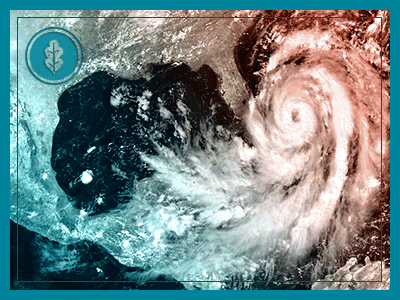 Cocaine's return to prominence at the end of the 1970s set the phase for the era of "sex, drugs and rock and roll" in the 1980s. Rolling Rock magazine profiled the decade as beingness one of "extreme" sexual activity, drug use and, of grade, rock music. A survey conducted by the magazine found that twenty percent of respondents admitted to trying cocaine.16 Furthermore, as the Civil Rights motion notched up victory after victory for blackness Americans, the negative clan between race and cocaine eroded. Cocaine became a drug that rock stars and celebrities used to stay up all night, have unbridled fun, and be part of a scene that was irresistibly decadent and bonny, making it the ultimate social lubricant and condition symbol. Disturbingly, this image yet persists to this day.17
Cocaine's return to prominence at the end of the 1970s set the phase for the era of "sex, drugs and rock and roll" in the 1980s. Rolling Rock magazine profiled the decade as beingness one of "extreme" sexual activity, drug use and, of grade, rock music. A survey conducted by the magazine found that twenty percent of respondents admitted to trying cocaine.16 Furthermore, as the Civil Rights motion notched up victory after victory for blackness Americans, the negative clan between race and cocaine eroded. Cocaine became a drug that rock stars and celebrities used to stay up all night, have unbridled fun, and be part of a scene that was irresistibly decadent and bonny, making it the ultimate social lubricant and condition symbol. Disturbingly, this image yet persists to this day.17
The decade also benefitted from what TheNew York Times referred to as "the greatest, [most] consistent outburst of economical activity" the earth had ever seen. From 1982 to 1989, there was the creation of 18.7 meg new jobs, with $thirty trillion worth of goods and services produced. A generation of young, ambitious men and women had a lot of money to burn.18 The era was infamously portrayed in the 2013 movie The Wolf of Wall Street , fix in 1987, which The Daily Beast called an "outrageously depraved orgy of sex activity [and] cocaine". Or "fun sexcapades and coke binges," in the words of a female character depicted in the flick.19, 20 The movie was based on Jordan Belfort, a former stockbroker who, co-ordinate to Business organisation Insider , crashed a helicopter, crashed his Mercedes, and sank a yacht while on a "cocaine diet."21
The 1980s may accept been a long time agone, but its days are fondly remembered by the financial industry that fueled itself with illegal cocaine apply. At a screening for The Wolf of Wall Street ,a scene where Jordan Belfort'due south character rips apart a absorber to get to his cocaine stash, was cheered on by existent-life Wall Street bankers.22
The Rise of Crack Cocaine
But cocaine couldn't keep upward with the rabid demand among the social elite. Towards the finish of the 1980s, cocaine manufacturers found themselves with the peculiar problem of non having enough of the drug to satisfy their customers. Corners had to be cutting. Suppliers used elementary baking soda to dilute the powdered, pure cocaine, making it cheaper to brand and buy. This newer, dirtier form of cocaine was no longer the purview of the rich and famous; at present, even the disenfranchised and poverty-stricken could get their hands on the drug.
Creating this grade of cocaine entails heating information technology until information technology produces a cracking sound, giving it its name: cleft cocaine, freebase cocaine, or simply "crack."23
When it hit the market, fissure cocaine caught on in a big way. The Primary Care journal writes that hospitalizations for medical emergencies as a result of using crack cocaine increased by over 100 percent from 1985 to 1986, the time period in which inner cities and gangs started to distribute it.24 According to Gallup, cocaine abuse had gone from a celebrity problem into a "truly terrifying issue." Gang warfare and the notion of "scissure babies" (children exposed to crack cocaine equally fetuses, causing premature nascency and other infant developmental problems) led to 42 pct of Americans challenge that crack (and other forms of cocaine) was the "most serious problem for (American) gild," even though, says Gallup, there are far more alcoholics than crack cocaine addicts.25
At that place is a meaning difference in how crack cocaine is perceived (vs. pure cocaine) in the Usa, and how its employ, possession, and distribution are punished past law enforcement. Numerous studies and examinations accept shown that people arrested for cleft cocaine-related reasons are given much more punitive charges than people who are arrested for charges related to the possession, use, or distribution of pure cocaine.
Mandatory Minimum Sentencing
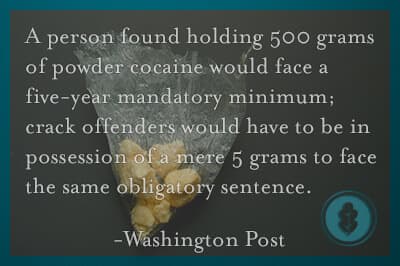 To illustrate this, the Washington Post uses the metric of mandatory minimum sentencing to highlight the disparity. A mandatory minimum jail term of five years would have been given to someone charged with possessing 5 grams of crack cocaine. On the other manus, a person would need to accept 500 grams of pure cocaine to receive the same jail term. In other words, the threshold for minimum mandatory sentencing for pure cocaine is literally 100 times that of cleft cocaine.26
To illustrate this, the Washington Post uses the metric of mandatory minimum sentencing to highlight the disparity. A mandatory minimum jail term of five years would have been given to someone charged with possessing 5 grams of crack cocaine. On the other manus, a person would need to accept 500 grams of pure cocaine to receive the same jail term. In other words, the threshold for minimum mandatory sentencing for pure cocaine is literally 100 times that of cleft cocaine.26
One might assume that cleft cocaine is more potent, more volatile than its powdered counterpart, hence why smaller amounts of crack receive the same punishments as larger amount of pure cocaine. The truth, nonetheless, is that there is no pregnant difference in the potential for habit betwixt crevice cocaine and powdered cocaine and both are just as illegal. As United states News & World Reportexplains, the deviation is non in the chemistry or addictive potential of crack cocaine; rather, the difference is found in who uses crevice cocaine (and who was punished for using it), and that answer is largely adamant by race.27
Or, as put a petty less subtly by theHuffington Post, white Americans do the crime of illicit drug use; black Americans get the time.28 ThePost quotes a 2009 report by Human Rights Lookout that points out that black Americans are three times more likely than white Americans to be arrested for drug possession, fifty-fifty though the difference between which racial groups utilise which drugs is minimal, at best.29
Sentencing Disparities
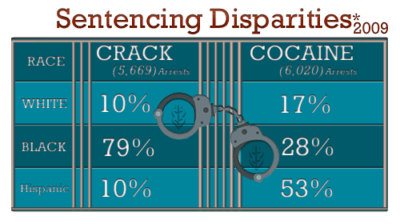
The U.s. Sentencing Commission says that no other drug has the same number of racially skewed offenses every bit crevice cocaine. In 2009, of the 5,669 crack cocaine offenders who were sentenced, 79 percent were black, 10 percent were white, and 10 percent were Hispanic. When it came topure cocaine, only 28 percent of the 6,020 offenders were black; 17 percent were white, and 53 percent were Hispanic .
Perhaps the near damning statistic of the mandatory minimum sentencing disparity is that people convicted of powdered cocaine-related charges spent an average of 87 months behind bars; on the other hand, people convicted of offenses related to crack cocaine were incarcerated for 115 months.
In writing that"it'south about time" that the law separating scissure cocaine and powdered cocaine sentencing was closed, the Los Angeles Times says that the difference between the two was never rooted in science (the way a law might have lesser punishments for marijuana- vs. heroin-related offenses). Instead, the divergence came downwardly to how crack cocaine users were perceived by the American legal system, the media, and the general public. Since crevice is easier for low-income people to obtain, says theTimes, and since low-income people cannot afford loftier-quality legal teams and rehabilitation facilities, low-income offenders are prosecuted much more harshly and regularly than richer (potentially white) offenders who don't carp with fissure cocaine.
Incarceration Nation and the Fair Sentencing Human action
 Senator Dick Durbin of Illinois pointed out that the uneven rest of the mandatory minimum sentencing practices between cleft cocaine and pure cocaine have led to African Americans being imprisoned six times more than than Caucasian Americans for the same illegal use, an ironic echo to the days when the "Negro cocaine fiend" pushed both cocaine and black Americans to the margins of society.thirty
Senator Dick Durbin of Illinois pointed out that the uneven rest of the mandatory minimum sentencing practices between cleft cocaine and pure cocaine have led to African Americans being imprisoned six times more than than Caucasian Americans for the same illegal use, an ironic echo to the days when the "Negro cocaine fiend" pushed both cocaine and black Americans to the margins of society.thirty
The American Psychological Association chimed in, saying that the disparity contributes to making the Usa the "incarceration nation." The land has v per centum of the global population, but 25 percent of the earth'southward prisoners, largely consisting of low-income people of color who do not accept an education.31
The Fair Sentencing Act of 2010, authored past Durbin, was signed into law by President Barack Obama to reduce the disparity betwixt how much crack cocaine and how much powdered cocaine would exist needed for federal criminal penalties to come into effect. From a 100:1 weight ratio, the divergence was whittled down to an 18:i weight ratio.32, 33
In supporting the passage of the Fair Sentencing Act, the American Ceremonious Liberties Wedlock argued that the previous system of mandatory minimum sentencing for crack cocaine offenses targeted African Americans, causing "vast racial disparities" in the length of prison sentences for similar crimes. Black Americans, says the ACLU, served an equal amount of fourth dimension in prison house for nonviolent legal offenses, as white Americans did for trigger-happy offences. The ACLU writes that the Fair Sentencing Act reduces not just the legal imbalance between sentencing for crack cocaine and powdered cocaine offenses, but also the racial imbalances created by a "draconian" system that turned people of colour against the American justice arrangement.
Fifty-fifty beyond that, the U.South. Sentencing Commission voted to retroactively extend the new Off-white Sentencing Human activity guidelines to people sentenced to prison for disparate crack cocaine offenses, even before the engagement of the law's enactment (Baronial 3rd, 2010). As a effect of that, 12,000 people (of whom 85 percent are African Americans) tin have their sentences for crack cocaine offenses reviewed by a federal judge, with the possibility of those sentences beingness reduced by the terms of the Fair Sentencing Act.
The U.South. Sentencing Committee approved an amendment to the Fair Sentencing Human activity, increasing the amount of crack cocaine that would be necessary to trigger the five-year mandatory minimum sentence; instead of 5 grams of possession, a person would at present have to be caught with 28 grams.34
Cocaine in America Today
The passage of the Fair Sentencing Act was a major stride forward in the history of cocaine in America; but in a like fashion that cocaine roared back into prominence in the latter half of the 20th century, even a milestone like the Off-white Sentencing Act has only made a paring in cocaine's presence in the United States. Past the time the notorious drug lord Joaquin Guzman, head of the Sinaloa Cartel, was arrested by Mexican authorities in 2016, it was estimated that he and his organization had distributed more than 500 tons of cocaine throughout the United States since the tardily 1980s.35
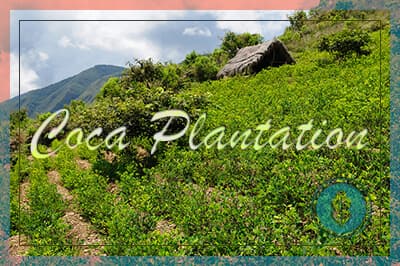
Furthermore, the United Nations Office on Drugs and Crime'southward 2011 World Report put the global value of cocaine at $85 billion in 2009, of which $38 billion came from the United States alone.36 The CIA World Factbook states that the United States is the leading cocaine-consuming state in the world, with South American countries (in item, Peru and Columbia) smuggling their product through Mexico and into the U.s..37, 38
Cocaine remains the 2d well-nigh pop drug in the world (behind marijuana), despite attempts by various South American governments to reclaim coca-producing territory from cartels, and regardless of its clear illegality in most countries.39 In 2016, the National Institute on Drug Abuse reported that nearly 5 meg people 18 or older had used cocaine in the past year in the United States.40 The National Survey of Drug Use and Wellness reports that virtually cocaine users are betwixt the ages of 18 to 25.41
Cocaine and Its Future in America
Cocaine in the United States has had a long, bumpy history. From being freely sold in grocery stores and by postal service-order vendors, to being declared Public Enemy Number One by President William Taft; from being used to scapegoat African-Americans, to existence the poison of option for A-listers, celebrities, and rock stars who died immature; from being reborn as crack cocaine to existence role of a multibillion dollar drug trade in a State of war on Drugs that has seen millions of lives ruined or ended. In 1993, the Journal of Clinical Pharmacology estimated that 25 percent of Americans—50 million people at the fourth dimension—had illegally used cocaine, with 6 one thousand thousand snorting or smoking information technology on a regular basis.42
While those numbers accept changed since the article was published, the upshot and presence of cocaine in America have not. It is non Public Enemy Number One anymore, as it was in the early on 20th century, and neither is it the most serious problem in American society, as Gallup polled in 1986. Notwithstanding, it is always on the fringes, only nether the radar, and there, mayhap, it is at its deadliest.
References
- "Cookies, Cocaine and Culture." (Oct 2013).Huffington Mail. Accessed Jan 11, 2016.
- "Oreos May Exist Every bit Addictive Every bit Cocaine." (October 2013).Fourth dimension. Accessed January 11, 2016.
- "A Brief History of Cocaine." (December 2013).Salon. Accessed Jan xvi, 2016.
- "Cocaine: The Evolution of the Once "Wonder" Drug." (July 2011).CNN. Accessed Jan sixteen, 2016.
- "Why We Took Cocaine Out of Soda." (January 2013).The Atlantic.Accessed Jan thirteen, 2016.
- "Coca-Cola Television receiver Advertisements: Dr. John S. Pemberton." (February 1996). Retentivity.loc.gov. Accessed Jan 13, 2016.
- "Traveling a Primeval Medical Landscape." (Apr 2010).The New York Times.Accessed January 12, 2016.
- "Cocaine: How "Miracle Drug" Nearly Destroyed Sigmund Freud, William Halsted." (Oct 2011).PBS Newshour. Accessed January 13, 2016.
- "An Anatomy of Habit — By Howard Markel — Book Review." (July 2011).The New York Times. Accessed January 16, 2016.
- "Negro Cocaine "Fiends" Are a New Southern Menace." (February 1914).The New York Times. Accessed January 16, 2016.
- "Why We Took Cocaine Out of Soda." (January 2013).The Atlantic.Accessed January xiv, 2016.
- "How the Myth of the 'Negro Cocaine Fiend' Helped Shape American Drug Policy." (January 2014).The Nation.Accessed January 13, 2016.
- "Cannabis: Hippie Dream, Modern Nightmare." (May 2008).The Guardian. Accessed Jan 13, 2016.
- "LSD, Ecstasy and a Boom of Utopianism: How 1967'south "Summertime of Dear" All Began." (June 2012).Vanity Fair.Accessed Jan 13, 2016.
- "These Shameless Cocaine Ads Evidence the '70s Were a Hell of a Time to Be Live." (September 2015).AdWeek.Accessed January thirteen, 2016.
- "TheRolling Stone Survey: On Sexual practice, Drugs and Rock & Scroll." (1988).Rolling Stone. Accessed Jan sixteen, 2016.
- "When Cocaine Was Absurd." (July 2011). Dangerous Minds. Accessed January fourteen, 2016.
- "The Reagan Boom — Greatest Ever." (January 1990).The New York Times. Accessed January fourteen, 2016.
- "The 21 Craziest Moments in "The Wolf of Wall Street": Cocaine-Fueled Orgies and More." (December 2013).The Daily Animate being. Accessed January 14, 2016.
- "Existent-Life Wolf of Wall Street Says his Life of Immoderacy "Even Worse" than in Film." (February 2014).The Guardian. Accessed January 14, 2016.
- "Croaky Tales of Cocaine on Wall Street." (July 2012).Business concern Insider. Accessed Jan 14, 2016.
- "We Saw "Wolf of Wall Street" With a Bunch of Wall Street Dudes and It Was Disturbing." (Dec 2013). Concern Insider. Accessed January fourteen, 2016.
- "Cocaine vs. Cleft." (north.d.) Diffen. Accessed January 14, 2016.
- "Stimulant Abuse: Pharmacology, Cocaine, Methamphetamine, Treatment, Attempts at Pharmacotherapy." (March 2012).Primary Care Journal. Accessed January xv, 2016.
- "Decades of Drug Use: The 80s and the 90s." (July 2002). Gallup. Accessed January 16, 2016.
- "The Fair Sentencing Act Corrects a Long-Fourth dimension Incorrect in Cocaine Cases." (August 2010). Washington Post. Accessed January xv, 2016.
- "Data Show Racial Disparity in Fissure Sentencing." (Baronial 2010).US News & World Study. Accessed January xv, 2016.
- "When It Comes To Illegal Drug Utilise, White America Does The Criminal offence, Black America Gets The Time." (September 2013).The Huffington Post. Accessed January 16, 2016.
- "Race, Drugs and Law Enforcement in the U.s.a.." (2009). Human Rights Spotter. Accessed January 16, 2016.
- "The Off-white Sentencing Human action of 2010: Information technology's About Time." (July 2010). Los Angeles Times. Accessed Jan 15, 2016.
- "Incarceration Nation." (October 2014). American Psychological Association. Accessed January xv, 2016.
- "Fair Sentencing Act." (n.d.) American Civil Liberties Marriage. Accessed January sixteen, 2016.
- "Bill Targets Sentencing Rules for Crack, Powder Cocaine." (October 2009). Washington Post. Accessed January 16, 2016.
- "U.S. Sentencing Committee: Terminal Crack Retroactivity Data Report — Off-white Sentencing Human activity." (December 2014). U.s. Sentencing Commission. Accessed January 16, 2016.
- "El Chapo Faces Assortment of Drug Charges in the United states of america." (January 2016).The New York Times.Accessed Jan 16, 2016.
- "World Drug Report, 2011." (2011). United nations Office on Drugs and Offense. Accessed January sixteen, 2016.
- "The Earth Factbook." (n.d.) Central Intelligence Agency. Accessed Jan sixteen, 2016.
- "U.S.: Republic of peru Overtakes Colombia equally Top Cocaine Producer." (July 2012).NBC. Accessed January 16, 2016.
- "Due south America'south Cocaine Industry on the Reject, Impacting the International Drug Market." (March 2015). Latin Post. Accessed Jan 16, 2016.
- "What Is the Scope of Cocaine Utilise in the United States?" (September 2010). National Constitute on Drug Abuse. Accessed January 16, 2016.
- "National Survey of Drug Apply and Health." (due north.d.) National Constitute on Drug Abuse. Accessed Jan 16, 2016.
- "Cocaine Abuse in Due north America: A Milestone in History." (April 1993).Journal of Clinical Pharmacology.Accessed January 16, 2016.
Source: https://riveroakstreatment.com/cocaine-treatment/illegal-history-in-america/
0 Response to "When Did Homeschooling Become Legal Again in Us"
Post a Comment